2017 Acura MDX Sport Hybrid
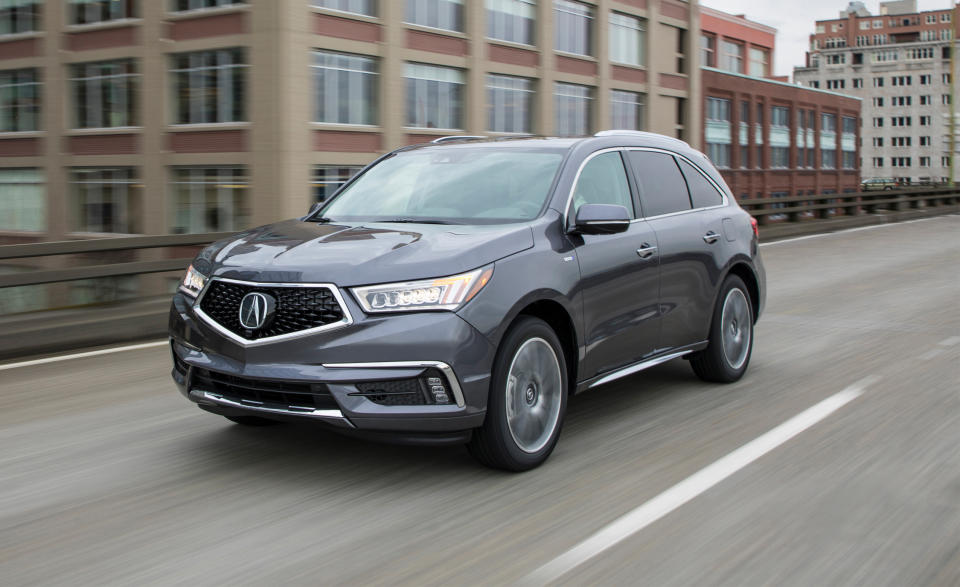
The promise of hybrid technology is that it can make vehicles better—more efficient, superior performing, and more satisfying to drive. But that hybrid halo often is held on by bobby pins and duct tape. In many luxury hybrids, off-the-rack gasoline-electric technology can make for an underwhelming, slow-witted driving experience, even if they sometimes are objectively quicker than their less expensive nonhybrid counterparts.
The 2017 Acura MDX Sport Hybrid SH-AWD is a rare exception, as it lives up to its potential, at least upon our first exposure. Part of the reason likely is the years of intense development behind its key hybrid components. Core items from the NSX supercar (and the forgotten—and forgettable—RLX Sport Hybrid sedan) have been transplanted into what is the brand’s best-selling vehicle. The technology that makes the NSX so ferocious in the corners and so drama free in general adds confidence, a sharper driving experience, and more miles per gallon to this high-riding, seven-passenger family wagon.

Better Reaction Times All Around
The nonhybrid MDX SH-AWD is a tough act to follow; it’s among the best-handling three-row crossovers, with quick, well-weighted steering and well-controlled body motions. Both MDX models feature an all-wheel-drive system—optional in the regular one, standard in the hybrid—that sends more torque to the outside rear wheel during hard cornering, but the Sport Hybrid goes a step further with the ability to apply resistance (and recover energy) at one rear wheel while it’s delivering forward momentum to the other. It thus achieves a sophisticated and more nuanced form of torque vectoring. The hybrid system also does away with a mechanical connection between the engine and the rear axle. Instead, a Twin Motor Unit (TMU) packages two 36-hp motors together at the rear. They fill gaps in the engine’s torque curve to sharpen accelerator response in the hybrid compared with the conventional model, and Acura engineers boast that the system takes just 90 milliseconds to fully adjust the torque distribution among the wheels versus about 0.2 second in the regular MDX. In front, a third, 47-hp electric motor spins with the input shaft of the seven-speed dual-clutch automatic transmission and has three roles: delivering supplemental torque, helping smooth out shifts, and acting as a generator.
As for the transmission, it’s a partner in this system’s quick reaction times. By losing the ZF nine-speed automatic, which can bumble over its bounty of ratio choices (and sometimes fumbles the shifts themselves with a shudder), the seven-speed and hybrid motor system are all business, ripping through the gears with quickness and grace. You hear them work more than feel them, and, because of the hybrid system, the rush of passing power starts even before the transmission has downshifted.
The gasoline engine steps aside as the headliner of the show, even though it remains the essential piece. In place of the direct-injected 3.5-liter V-6 in other MDX models, the hybrid has a 3.0-liter V-6 with port injection, the smaller displacement enabling it to skirt a China-market tax on larger engines. The entire system makes 321 horsepower and 289 lb-ft, or 31 hp and 22 lb-ft more than the nonhybrid models.
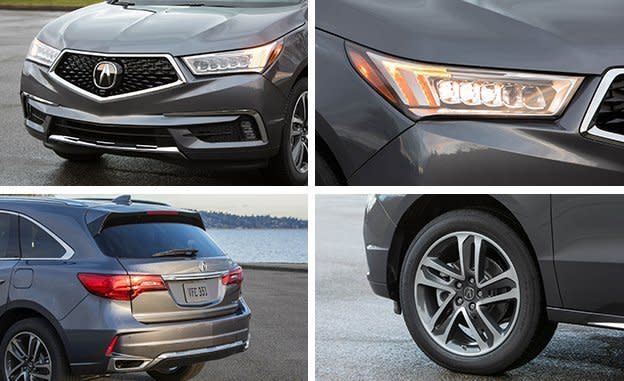
Moving along with city traffic, it’s clear that Acura’s hybrid know-how extends to more than carving up mountain-road esses. The hybrid system brings the V-6 seamlessly into the mix with a wet multiplate clutch, finessing the low-speed drivability issues that can plague such a setup. Accelerate gently and the MDX hybrid launches silently, as a rear-wheel-drive electric vehicle. The V-6 comes on shortly thereafter, although it often switches off when coasting (at speeds up to 56 mph). We also saw it cycle off in steady 40-mph cruising.
The fine MDX driving experience hasn’t been adulterated in any other way. It includes well-blended brakes and precise, nicely weighted steering. There’s a fair amount of body lean, as expected in a vehicle like this, but the adaptive dampers do a great job filtering out road harshness. Push hard into tight corners and you might find yourself dialing in too much steering input, as the outside rear motor nudges the rotation, preempting understeer. A quick loop in a Lexus RX450h—the bestseller among the MDX’s U.S.-market rivals—showed a sharp contrast with the way Acura’s hybrid system doesn’t change accelerator response as the power sources swap in and out, thus reinforcing the idea that the system works as one cohesive unit.
Aiming to Blend In
Compared to the NSX or even the RLX, there was a greater effort to make the hybrid technologies invisible in the MDX, according to product planning manager Gary Robinson. The priorities here were simply strong acceleration and balanced performance, and outside of knowing when the engine switches off and on, it’s hard to discern what the hybrid system is doing and where torque is being delivered.
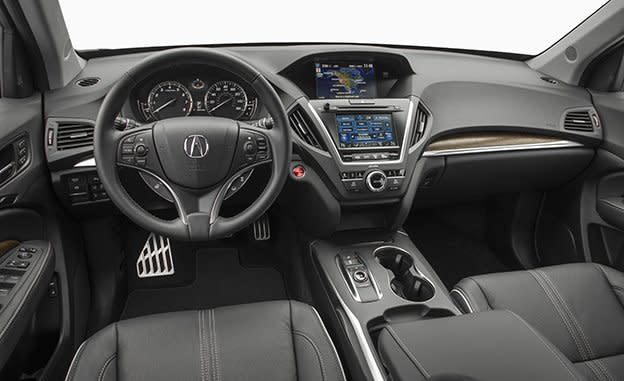
There nevertheless are four driving modes in the Sport Hybrid, up from three in other versions of the MDX. They vary throttle response, steering effort, and damper behavior. The one that’s hybrid-exclusive and takes advantage of this model’s added performance is Sport+, which keeps the engine running all the time, freeing up the front motor to maximize acceleration and to assist with shift quickness.
Acura says the hybrid kit adds 227 pounds to the curb weight of the MDX, versus the standard AWD model—which is already around 200 pounds heavier than an equivalent front-drive version. But because much of the hybrid hardware is mounted low in the chassis, the Sport Hybrid has a center of mass that’s about an inch lower. The fitment of all this extra hardware has no effect on packaging. Ground clearance is the same as the standard MDX. Seating is still comfortable for five in the first two rows (or four, if you get the Advance model and its second-row captain’s chairs), and good enough for kids in the third row; the seats fold neat and flat; and cargo space is uncompromised.
If the motor systems around the axles are the muscle of the hybrid system, the Intelligent Power Unit (IPU) and Power Control Unit (PCU) are its brain and nerve center. Both have benefited from NSX development, and they’re mounted on additional structures (with crossmembers to help protect them) that span the length of the MDX’s underbody—essentially where the prop shaft otherwise would go. The PCU is liquid-cooled, while the IPU, where the 72-cell, 1.3-kWh lithium-ion battery pack lives, is located under the center console and cooled with air from the cabin.
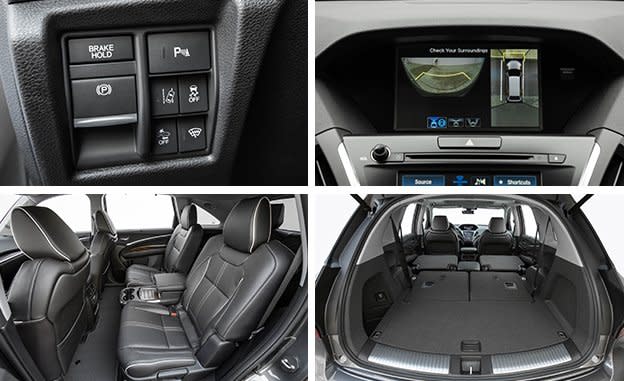
Why Not Go Hybrid?
There are two ways to get the Sport Hybrid. The Technology Package versions include 20-inch wheels, remote start, and perforated leather upholstery. The Advance Package adds heated and ventilated front seats, upgraded Milano leather with piping, open-pore wood trim, heated second-row captain’s chairs with a center console, sunshades for the second row, and LED fog lamps. All MDXs now come with crash-mitigation braking, lane-keeping assist, adaptive cruise control, and other active-safety features.
With a boost of 8 mpg in the city and 1 mpg on the highway versus the standard all-wheel-drive MDX at an extra cost of just $1500, it’s hard to conceive of a reason not to get the Sport Hybrid over the standard MDX—even for those who do tend to do more highway driving.
There are a couple of drawbacks, however. For all the NSX wizardry built in here, the system in the MDX Sport Hybrid isn’t really meant for high-speed driving. At 84 mph, just short of the rear motors’ 11,000-rpm redline, a one-way clutch decouples them. Beyond that speed, the non-hybrid models, with their larger 3.5-liter V-6 and less weight, likely would start pulling away from the hybrid. The more significant issue is towing. It’s not recommended at all for the hybrid, according to powertrain development leader Ken Lantz, who claims that the majority of MDX owners don’t tow anyway.
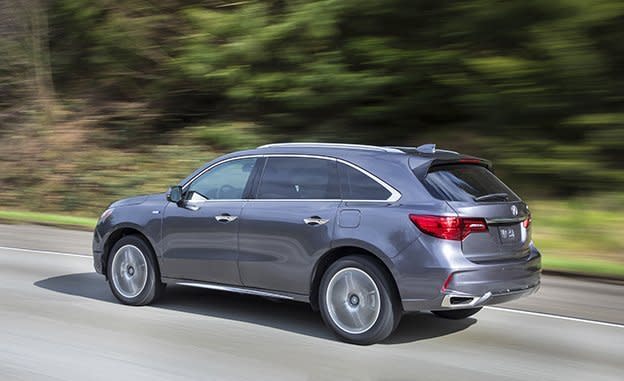
Other than badging, there’s not much to distinguish the hybrid from other versions on the outside. All MDXs received a light refresh for 2017, one that’s most noteworthy in front, where Acura shed the last remnants of the former model’s awkward metallic beak, subbing in a more conventionally styled grille. The hood gets some corresponding new character lines, there are new wheels, and the return of dual exhausts sum the changes on the outside. Inside Acura has introduced second-row captain’s chairs and revamped some of the trim and surfaces. The company expects the MDX hybrid’s target buyer to be both significantly younger and more affluent than those who go for the non-hybrid models. Considering that, the hybrid’s interior feels conservative—if a bit drab—for the mission. And years after its introduction, the dual-screen infotainment system still confounds and infuriates.
Acura is planning to sell only 5 to 10 percent of all MDXs in hybrid form, but perhaps that will prove to be an underestimate. For all the complexity, the hybrid gear makes the MDX better to drive and less thirsty. Here, the halo seems real.
Specifications >
VEHICLE TYPE: Front-engine, all-wheel-drive, 6- or 7-passenger, 4-door hatchback
BASE PRICES: Technology, $52,935;
Advance, $58,975
ENGINE TYPE: SOHC 24-valve 3.0-liter V-6, 257 hp, 218 lb-ft; 2 permanent-magnet synchronous AC synchronous motors, 36 hp (each), 54 lb-ft (each); permanent-magnet AC synchronous motor, 47 hp, 109 lb-ft; combined system, 321 hp, 289 lb-ft; 1.3-kWh lithium-ion battery pack
TRANSMISSION: 7-speed dual-clutch automatic with manual shifting mode
DIMENSIONS:
Wheelbase: 111.0 in
Length: 196.2 in
Width: 77.7 in Height: 67.4 in
Passenger volume: 133 cu ft
Cargo volume: 15 cu ft
Curb weight (C/D est): 4500 lb
PERFORMANCE (C/D EST):
Zero to 60 mph: 5.8 sec
Zero to 100 mph: 16.3 sec
Standing ¼-mile: 14.5 sec
Top speed: 110 mph
FUEL ECONOMY (C/D EST):
EPA combined/city/highway: 27/26/27 mpg

 Yahoo Autos
Yahoo Autos 